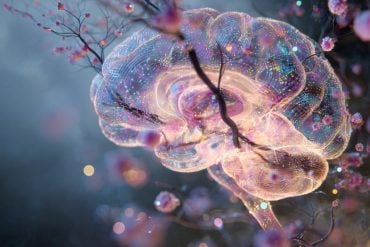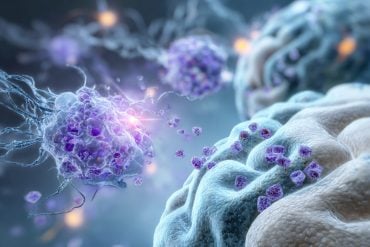Summary: The muscle hormone irisin, elevated during exercise, may aid in battling Alzheimer’s disease (AD). Using advanced 3D cell models of AD, the research demonstrates that irisin treatment drastically reduces amyloid beta pathology. This effect is attributed to the boost in neprilysin, an enzyme breaking down amyloid beta. These discoveries hint at potential irisin-based treatments for AD in the future.
Key Facts:
- Irisin, a hormone elevated by exercise, shows significant potential in reducing Alzheimer’s hallmark amyloid beta deposits.
- The hormone achieves this by increasing levels of neprilysin, an enzyme responsible for degrading amyloid beta.
- Irisin’s effect was discovered by binding to integrin αV/β5 on astrocytes, leading to elevated neprilysin and decreased amyloid beta.
Source: Mass General
Researchers who previously developed the first 3D human cell culture models of Alzheimer’s disease (AD) that displays two major hallmarks of the condition—the generation of amyloid beta deposits followed by tau tangles—have now used their model to investigate whether the exercise-induced muscle hormone irisin affects amyloid beta pathology.
As reported in the journal Neuron, the Massachusetts General Hospital (MGH)–led team has uncovered promising results suggesting that irisin-based therapies might help combat AD.

Physical exercise has been shown to reduce amyloid beta deposits in various mouse models of AD, but the mechanisms involved have remained a mystery.
Exercise increases circulating levels of the muscle-derived hormone irisin, which regulates glucose and lipid metabolism in fat tissue and increases energy expenditure by accelerating the browning of white fat tissue.
Studies have revealed that irisin is present in human and mouse brains and that its levels are reduced in patients with AD and in mouse models of the condition.
To test whether irisin plays a causal role in the link between exercise and reduced amyloid beta, Se Hoon Choi, PhD and Eun Hee Kim, PhD, of the Genetics and Aging Research Unit at MGH, along with additional research colleagues applied the hormone to their 3D cell culture model of AD.
“First, we found that irisin treatment led to a remarkable reduction of amyloid beta pathology,” says Choi. “Second, we showed this effect of irisin was attributable to increased neprilysin activity owing to increased levels of neprilysin secreted from cells in the brain called astrocytes.”
Neprilysin is an amyloid beta–degrading enzyme that has been found to be elevated in the brains of mice with AD that were exposed to exercise or other conditions leading to reduced amyloid beta.
The researchers uncovered even more details about the mechanisms behind irisin’s link to reduced amyloid beta levels. For example, they identified integrin αV/β5 as the receptor that irisin binds to on astrocytes to trigger the cells to increase neprilysin levels.
Furthermore, they discovered that irisin’s binding to this receptor causes reduced signaling of pathways involving two key proteins: extracellular signal-regulated kinase (ERK) and signal activator of transcription 3 (STAT3). Reduced ERK-STAT3 signaling was critical for irisin-induced enhancement of neprilysin.
Previous studies have shown that in mice, irisin injected into the blood stream can make its way into the brain, making it potentially useful as a therapeutic.
“Our findings indicate that irisin is a major mediator of exercise-induced increases in neprilysin levels leading to reduced amyloid beta burden, suggesting a new target pathway for therapies aimed at the prevention and treatment of Alzheimer’s disease,” says Rudolph Tanzi, PhD, a senior author of the study and director of the Genetics and Aging Research Unit.
Additional co-authors include Hyeonwoo Kim, Mark P. Jedrychowski, Grisilda Bakiasi, Joseph Park, Jane Kruskop, Younjung Choi, Sang Su Kwak, Luisa Quinti, Doo Yeon Kim, Christiane D. Wrann, and Bruce M. Spiegelman.
Funding: This research was supported by Cure Alzheimer’s Fund (R.E.T., S.H.C., and C.D.W.); JPB Foundation (R.E.T. and B.M.S.); NIH R56AG072054 and 1R21AG062904 (S.H.C. and C.D.W.); Coins for Alzheimer’s Research Trust (S.H.C.), and BrightFocus Foundation Fellowship A2020870F (E.K.).
About this Alzheimer’s disease and exercise research news
Author: Brandon Chase
Source: Mass General
Contact: Brandon Chase – Mass General
Image: The image is credited to Neuroscience News
Original Research: Open access.
“Irisin reduces amyloid-b by inducing the release of neprilysin from astrocytes following downregulation of ERK-STAT3 signaling” by Se Hoon Choi et al. Neuron
Abstract
Irisin reduces amyloid-b by inducing the release of neprilysin from astrocytes following downregulation of ERK-STAT3 signaling
Highlights
- Irisin promotes NEP secretion, leading to Aβ decrease in 3D-AD culture
- Integrin αV/β5 serves as the irisin receptor on astrocytes to induce NEP secretion
- Irisin-induced NEP secretion is mediated by downregulating ERK-STAT3 signaling
Summary
A pathological hallmark of Alzheimer’s disease (AD) is the deposition of amyloid-β (Aβ) protein in the brain. Physical exercise has been shown to reduce Aβ burden in various AD mouse models, but the underlying mechanisms have not been elucidated. Irisin, an exercise-induced hormone, is the secreted form of fibronectin type-III-domain-containing 5 (FNDC5).
Here, using a three-dimensional (3D) cell culture model of AD, we show that irisin significantly reduces Aβ pathology by increasing astrocytic release of the Aβ-degrading enzyme neprilysin (NEP). This is mediated by downregulation of ERK-STAT3 signaling.
Finally, we show that integrin αV/β5 acts as the irisin receptor on astrocytes required for irisin-induced release of astrocytic NEP, leading to clearance of Aβ.
Our findings reveal for the first time a cellular and molecular mechanism by which exercise-induced irisin attenuates Aβ pathology, suggesting a new target pathway for therapies aimed at the prevention and treatment of AD.






